 |
|||||||||||||
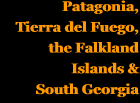 |
|||||||||||||
 |
|||||||||||||
 |
|||||||||||||
Main pages
Appendices
4 Pichi-Ropulli Osorno report •
9 Branchline station photos 2 •
11 Barros Jarpa Noel agreement ª
Chapter 5
The south end of the Chilean broad gauge


The Ferrocarril Trasandino por San Martín
In the midst of all those broad gauge routes, there ran for seventy years a solitary metre gauge branch, not through lack of logic on the part of the EFE, but as the forlorn relic of a projected international railway.
The Sociedad Camino, Lacoste y Cía., of Valdivia, had major timber and farming interests around lakes Riñihue, Panguipulli and Pirihuaico. As well as an interest in improving transport links from that area, they had recognised that a difficulty for most of the Trans-Andine railway proposals was to raise sufficient capital to build a very expensive route all the way across the mountains in one go. Their suggested alternative would have run from the small town of Collilelfu, later Los Lagos, on the southern broad gauge mainline east of Valdivia, through to San Martín de los Andes in Argentina’s Neuquén province north of Bariloche. At that time the western parts of Neuquén could more easily trade with Chile than across the desert eastward; indeed some of the FC Sud’s engineers surveying the route covered in Chapter 3 had initially travelled via Mendoza and Santiago and then southward to reach their destination.
The big difference from all the other schemes was that this route could be constructed in a number of discrete stages, using lake steamers and dirt roads in the interim until each additional length of railway could be funded and built. In addition, the pass was no higher than 650 m. (2150’), thought to be reachable using short stretches of 1 in 33 grade (3%) and without long tunnels or much risk of blockage by snow.
The route may be more easily understood if set out step by step, as in the table on the following page. From this it may be seen that initially a through journey from Valdivia to San Martín de los Andes would have required several separate rail journeys, three lake steamers, and lengths of gravel road, not to mention the necessary six upheavals and changes! No doubt that was what was already involved for the goods being sent that way to the western parts of Neuquén, but it was hardly a journey to tempt the faint-hearted, nor indeed those shipping fragile goods. As Señor Santiago Marín Vicuña wrote in 1916, “this international route is at present more picturesque than economic…” (2)
Work starts
Capital of £500,000 (in £1 shares) was raised at the beginning of the 20th century, and it is said that three locomotives, two steel bridges, and other materials were ordered in Germany, along with the steamer Riñihue that was to provide the passenger service on the lake of that name (3). That might be true, but if so then someone was being rather presumptuous, for the government concession was only granted in 1905, with two years being allowed for the proposals to be worked up. At this stage the company were still hedging their bets as to the most suitable gauge of track for the project, and were to be permitted to choose between the broad gauge (5’ 6”), metre gauge, or 750 mm. gauge (approx. 2’ 6”) depending on the results of surveys.
In fact the detailed plans for a metre gauge railway to Riñihue were approved in 1906, and those for the section beyond Lago Riñihue as far as Puerto Fuy in 1908.4 Permission was also granted for the company to install a third rail along the EFE’s broad gauge from Collilelfu to the Cuesta de Soto outside Valdivia, where a new metre gauge station and wharf would have facilitated links with the outside world. The agreement allowed for a daily freight each way (5).
The promoters formed a subsidiary to construct and operate the railway – la Compañía Comercial i Ganadera Jeneral San Martín – and work seems have begun on the first section fairly quickly. The first 30 km. to Huidif station were opened in 1909, including the two principal bridges over the rivers Collilelfu and Quinchilca. Disappointingly, funds then dried up, with several kilometres of earthworks down the hill to the lakeside terminus yet to be completed. In the meantime the company’s steamer Riñihue, built in Bremen, sailed out to Valdivia via the Straits of Magellan and was then broken down into pieces for the two stage rail trip inland, having to be dragged on rollers for the final few kilometres to its reassembly point.
One of the pair of Borsig 0-6-0Ts is seen at work in the deep cutting on the approach to the Río Quinchilca during the construction period.
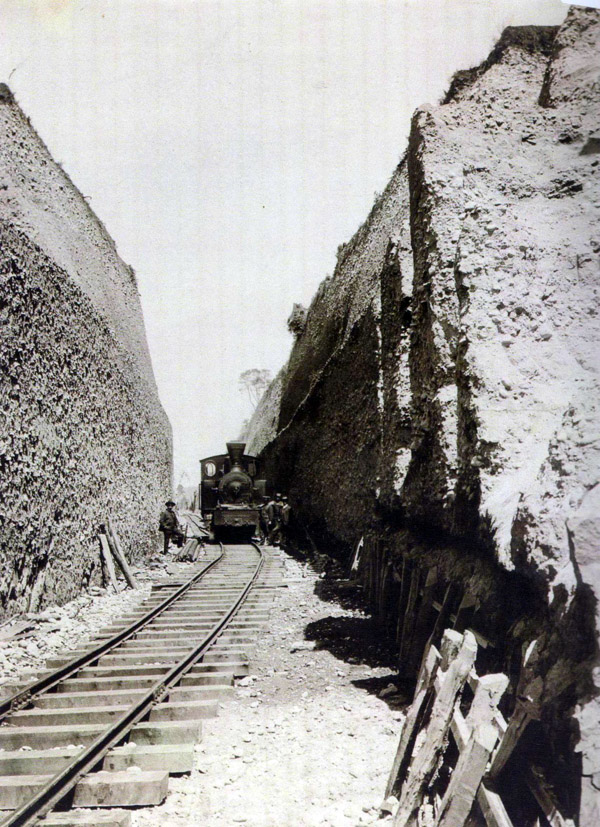
Perhaps by then realising that all was not well, and despairing of ever completing even this first 40 km. section of line to Riñihue, in 1910 the owners offered the uncompleted railway to the government (6). The biggest problem was that the anticipated 15,000 Chilean pesos per kilometre for construction, calculated on the basis of a 750 mm. gauge line, had risen to 50,000 pesos by the time that the actual metre gauge works were under way. Some of this may well have been due to a lack of experience by Chilean engineers in creating satisfactory and stable trackbeds in the climate and soil conditions of the temperate rainforest – a problem that became even more acute on Chiloé Island a year or two later. However, in this case the DOP’s engineers, reviewing the situation in order to advise the government as to whether the purchase was in their best interests, were more critical, as the quote that began the chapter illustrated.
And so, in January 1911 the Minister of Industry & Public Works politely declined the offer, commenting that: the Director General of the railways, who was asked to report about the consequences for the (EFE) of acquiring this railway, said that because of the condition of the route, the operation of the line would be costly for the company, as the receipts would not be enough to cover the expenses.
On the other hand the development of the railway is (also) dependent, (not only) on its completion to Lago Riñihue, but also on the construction of the 35 kilometres of track between the lakes Riñihue and Pirihuaico and of the 12 that would create the link between Lago Pirihuaico and the port of Huahun on Lago Lacar (7).
An early view looking down on Riñihue station and with the lake behind.
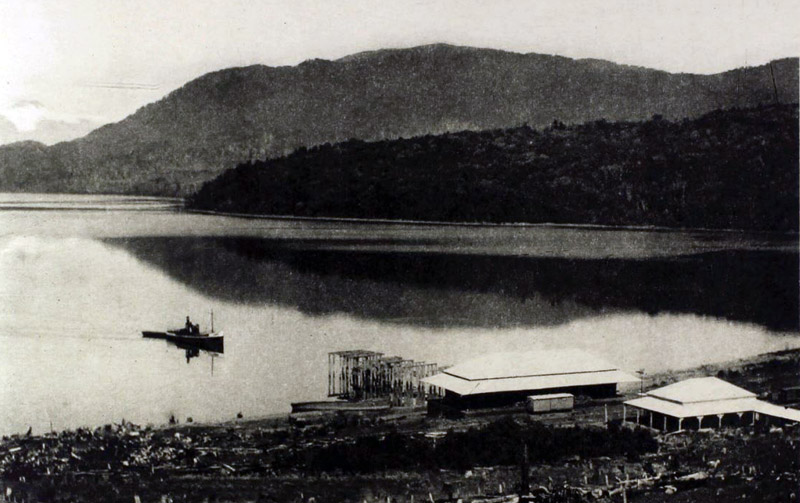
A view from the opposite direction, with a Borsig loco attached to a small coach, and with piles of the railway’s main cargo – timber – in the foreground.
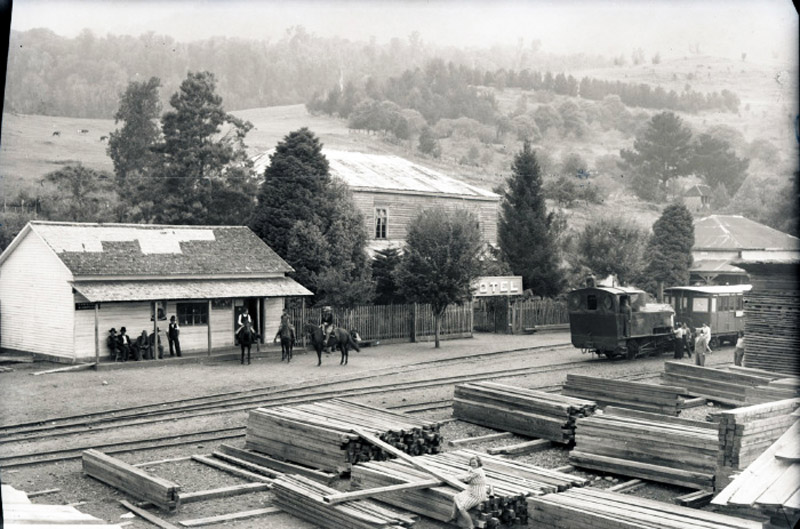
The first section opens
With no alternative, the owners had to make the best of a bad job (8). The company had already built a jetty at the site of Riñihue station, and possibly others along the lake. The steamer could therefore be brought into use, with a lighter towed behind to bring timber across, and eventually traffic built up sufficiently to permit the completion of the first railway section by around 1916.
Nevertheless, the delay proved fatal to any hopes of extending beyond the first lake. The First World War was by then hitting economies all over the world; there was a temporary fall in the Pound Sterling in which the railway’s shares had been issued; and by the end of the conflict artificial replacements for Chilean nitrate had pulled the plug on the country’s major export industry.
In addition, the hopes of a gently graded line all the way to the border and beyond had been dashed by the detailed survey showing that four kilometres of rack at a gradient of 1 in 16 (6%) would be necessary to get up past the Huilo-Huilo falls on the Fuy river, part way along the second section.
Thus the once ambitious hopes led only to a 40 km. (25 mile) branch line, and one, moreover, with the added handicap of being of a different gauge from the mainline out of which it sprang. As the 1940 timetable displayed on the opposite page shows, the Trasandino/Transandino name remained in use, but all hope of further extension had been extinguished by that date.
The original terminus station at Collilelfu, later Los Lagos, still survives.
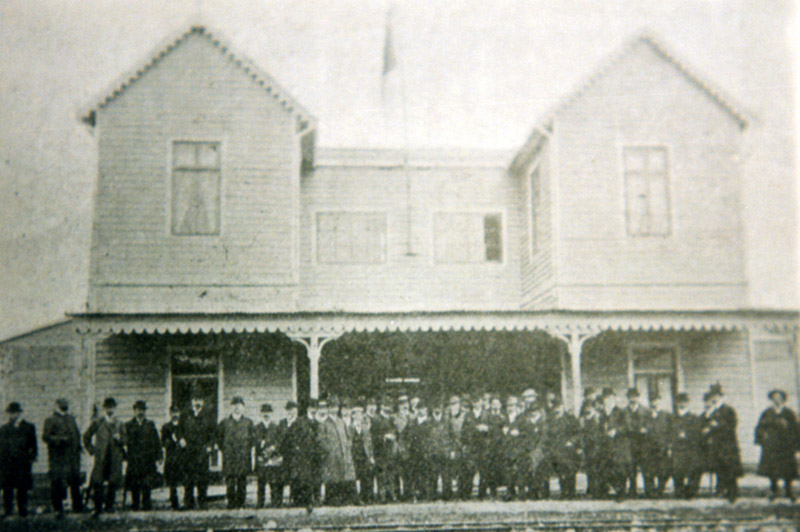
Locomotives and equipment
Knowledge of the railway’s original locomotives is currently limited. Three are supposed to have been shipped, rumour has it from Hamburg, named Collilelfu, Graciela and San Martín, of which two were 0-6-0Ts weighing 24 tonnes each and the other, ‘a four-coupled tender engine’, 16 tonnes (10). The photos seen so far imply that the 0-6-0WTs were by Borsig and the 0-4-0T by Hanomag.
Unfortunately, it has not yet been possible to identify them in builders’ lists, though there were several Borsig metre gauge tank locos delivered to unidentified customers in Chile via various agents in Hamburg around 1908. All three of the machines we are looking for ran on wood fuel and it is possible that an 0-4-0T would have needed a tender adding for this purpose, thus bringing it into line with the description above.
We do have some idea of the stock that the railway started operations with – two coaches, a single van, two high-sided wagons, and eleven flats (11). Conflicting reports from the late 1920s and the 1930s suggest that these had been augmented, principally by the acquisition of up to eighteen more planos, no doubt for the timber traffic, and by a third passenger coach.12 13 The couplings used at that time are unknown. Although after nationalisation the line used Sharon centre buffer-couplers like the rest of the EFE metre gauge, this is unlikely to have been the case during the railway’s earlier independent existence.
The track had been constructed using 20 kg./m. (40 lb./yard) rail on wooden roble pellín sleepers, to national standards, in this case implying minimum radius curves of 150 m., and a ruling grade of 2.4 or 3% (1 in 42 or 1 in 33) depending on the source consulted. The route started from Collilelfu station, but with a half mile extension west involving a single steel truss bridge to reach the broad gauge station that was later renamed Los Lagos.
One of the pair of Borsig 0-6-0Ts on a construction train close to the Río Collilelfu bridge.
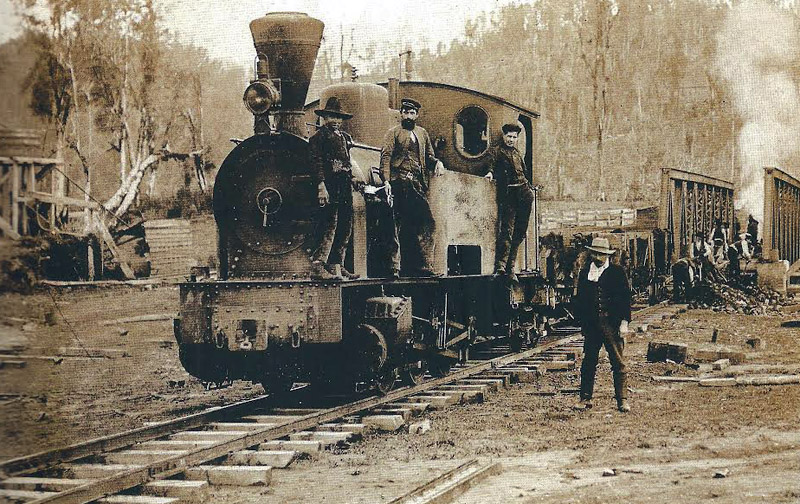
The third loco seems to have been a Hanomag 0-4-0WT, possibly used with an improvised tender carrying wood fuel.
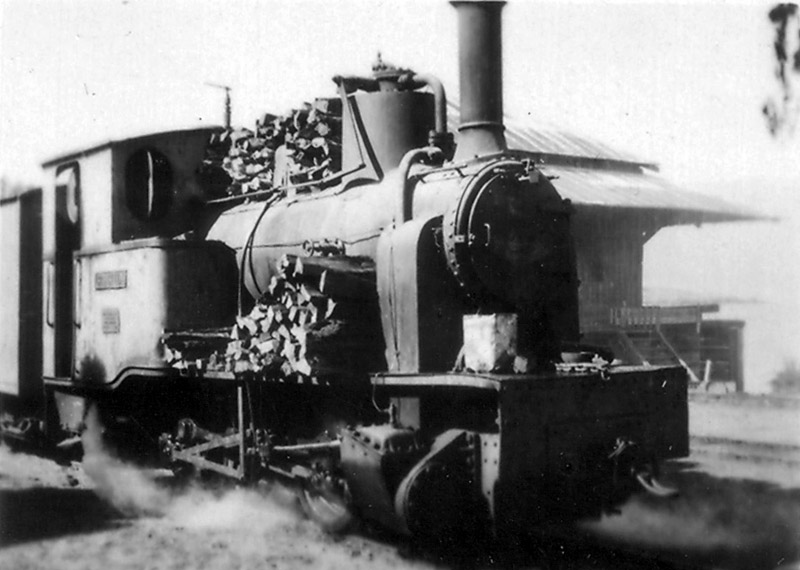
Operations
By the time that trains started in earnest, the original operating company had been dissolved and replaced by another, the SA Trasandino San Martín, tasked with its completion and operation. Despite the lack of progress on any extension, the railway and its attendant steamer service were financially viable, largely owing to the timber traffic brought across the lake in a lighter towed by the Riñihue for onward shipment by train.
W. Rodney Long’s US Bureau of Foreign & Domestic Commerce report published in 1930 states that rail freight traffic was around 20,000 tons in 1926 and ’27, and that the business had made a profit every year that decade, except 1923 when expenses for some reason had been abnormally high (14). Passenger traffic, on the other hand, was only about 6000 journeys per year, though it had doubled since the beginning of the decade. At that time only two passenger trains per week were run, though during the following decade that increased to roughly a train per day.
The US report, incidentally, records only two steam locos in use, and only 14 goods wagons, with the two passenger coaches as at the opening. Señor Daniel Oliva was the manager, with a staff of 43 – not excessive if this included the steamer operation as well.
Part of the page on this railway, in the 1930 American report on Chile’s railways.
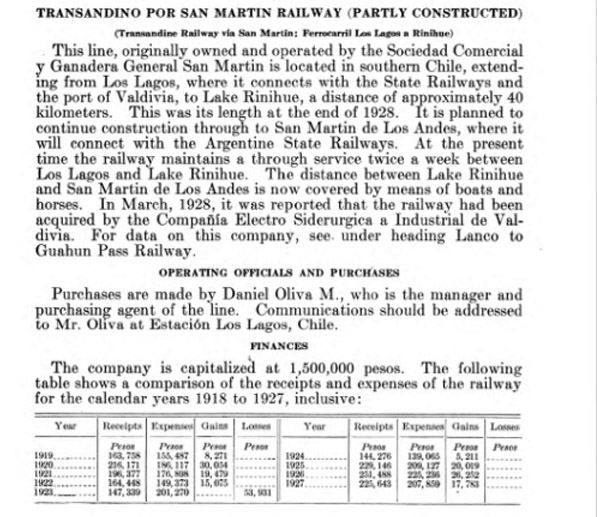
Further data can be found in the annual Estadística reports. That for 1937 suggests that trains were by then run as passenger or mixed services, there being no specific goods trains (15). The total loco kilometrages of around 32,000 on passenger trains and 46,000 on mixtos implies around 8 passenger and 11 mixed journeys each way per week along the 40 km. route, or three a day ignoring Sundays. By a long way the most important type of freight traffic was timber, brought across the lake and then shipped out by rail, with around 900 tonnes per week being carried.
Alternatively, by working back from the situation in the 1950s, about which much more is known, we can make some educated guesses about pre-war practice. The 540 hp. locos used later could pull five loaded bogie wagons – gross weight around 140 tonnes – up the hill from Riñihue. The original 0-6-0T tank locos, of 260 hp. by the EFE’s estimate, might therefore have taken a mixed train of two wagons and a coach. Now, using the pattern of loadings from the 1950s, out of roughly 53,000 tonnes of goods carried in 1937 perhaps 48,000 tonnes would have been westbound, and of that 20,000 would have been loaded at Riñihue with the rest mostly joining the railway at Huidif and Folilco (16). As our calculations above give a capacity of about 35 tonnes of revenue-earning load for each train, we again reach a figure of around 570 mixed trains per year or eleven per week climbing that hill, or maybe rather more if some were to have gathered a further wagon or two at the later stations. The climb up from the Río Quinchilca bridge to Cochui was only slightly less steep than the big bank but was vastly shorter and might well have been taken at a run from the downhill section immediately prior to the bridge. If the bridge coped with the enormously heavier locos brought in from the 1940s onward there would have been no worries about the small original engines.
The twice weekly passenger trains of the 1920s each carried perhaps 30 passenger each way, from the figures given above. Clearly these could have been accommodated in a single coach though two are more likely to have been used, perhaps with a van attached, or maybe hauled by the smaller 0-4-0 tender loco. Carlos Huidobro Díaz suggests around 7,500 passengers were carried in 1937, which is probably more accurate than the 1,800 given in the Estadística for that year, for if the latter figure were correct surely the company would have ceased to run so many passenger trains.
A single carriage passenger train at Huidif.
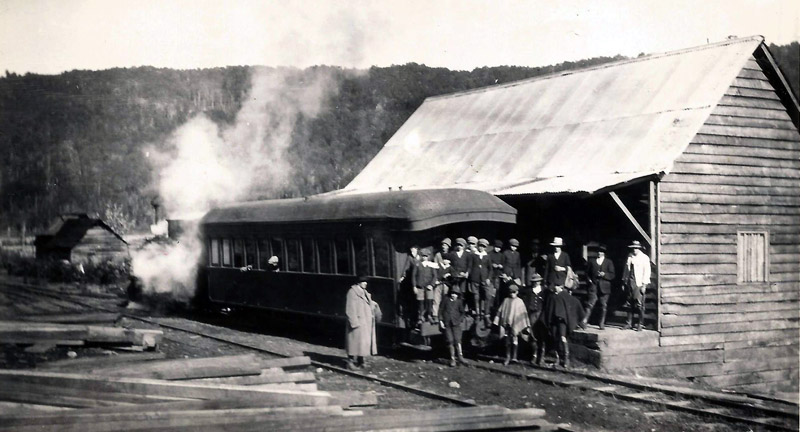
The railway’s timetable, probably from some time in the 1930s.
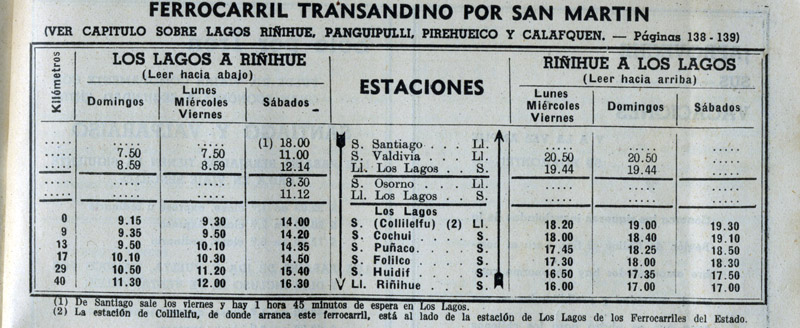
The later history of this line is covered on the next page.
References
1 Advisory report on the state and prospects of the railway, 1909, p8, in ArNAd volume MOBR2332. ArNAd = the Chilean Archivo Nacional de la Administración, at Avenida Matucana 151 in Santiago.
2 Santiago Marín Vicuña, 1916, Los Ferrocarriles de Chile, Imprenta Cervantes, Santiago, p91. Available online at http://www.memoriachilena.cl/temas/documento_detalle.asp?id=MC0057501
3 http://loslagoshistoriaypoesia.blogspot.com/2011_05_01_archive.html
4 Leopoldo E. Guillén, Monografía de los ferrocarriles de Chile, 1939. p40.
5 Various items of correspondence from 1908-9 contained in ArNAd volume MOBR1834.
6 ArNAd volume MOBR2332.
7 Decreto 105, 20 January 1911, in ArNAd volume MOBR2332, p96.
8 At this point the concession was transferred yet again, this time to the Sociedad Anónima Transandino por San Martín.
9 Leopoldo E. Guillén, 1939, Los Ferrocarriles de Chile. Monografía. Extracto de la Monografía de los Ferrocarriles de Chile, Santiago de Chile.
10 Inventory 1909 contained in ArNAd volume MOBR2332; Estadística volumes; and in W. Rodney Long, 1930, Railways of South America: Part 3: Chile, U.S. Bureau of Foreign and Domestic Commerce - Trade Promotion Series No. 93, U.S. Government Printing Office, Washington D.C.
11 Santiago Marín Vicuña, 1916, Op. cit., p95.
12 W. Rodney Long, 1930, Op.cit.
13 Estadística de los ferrocarriles en explotación, 1927, Santiago.
14 W. Rodney Long, 1930, Op.cit.
15 Estadística de los ferrocarriles en explotación, 1937, Santiago.
16 The goods traffic figures given here, from the Estadística de los ferrocarriles en explotación, 1937, are rather higher than those listed in Carlos Huidobro Díaz, Nuestros Ferrocarriles, 1939, Santiago.
16-3-2018